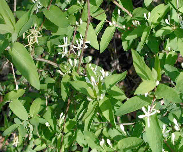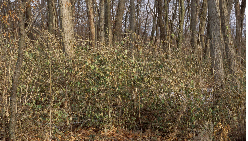Bush Honeysuckle
Lonicera maackii
Bush (Amur) Honeysuckle
Native Origin: This east Asian native was introduced to North America in 1896 as an ornamental plant and also was used for wildlife cover and soil erosion.
Description: An erect multi-stemmed deciduous shrub with arching branches that can grow up to 30 feet tall. The leaves are opposite, oblong to oval, 2 – 3 inches long. Plant stems are hollow. Fragrant tubular flowers appear in spring and age from white to yellow. Abundant red berries (1/4 in diameter) appear late summer through winter and are eaten by birds which spread the seed. The plant reproduces vegetatively and by seeds.
Habitat: Bush honeysuckle can grow in a wide range of soils and environs. Tolerant of both full sun and full shade, it grows in fencerows, thickets, woodlands, roadsides, pastures, disturbed sites, old fields and lawns. It is pollution tolerant and thrives on neglect, tolerating either severe drought or periodically water-logged soil. It now grows throughout the Eastern and Midwestern U.S.
Ecological Impacts: Bush honeysuckle readily grows and spreads through woodland areas, forming impenetrable understory thickets. It adversely impacts all other understory plants by creating dense shade and can halt tree seedling establishment and regeneration. One berry producing plant can soon spread into many colonies since the seeds are quickly and widely dispersed by birds and mammals.
Similar species: Our native sumacs (Rhus), possum haw (Ilex decidua) and coralberry (or buckberry) (Symphoricarpos orbiculatus) all have reddish fruits that persist into winter. Sumac produces berries in clusters at terminal ends; possum haw has grayish bark, does not occur in large colonies and does not have hollow stems; coralberry has much smaller fruit, less than 3/8 inch diameter, and does not have hollow stems.
Control and Management: Careful monitoring and repeat control methods may be needed because seed can remain and can be reintroduced from neighboring sites. Manual: Hand removal of seedlings and even small to medium sized plants is useful and effective. The shallow rooted plants can be pulled intact from moist soils.
Chemical: Foliar spraying may be the most effective method for large and widespread colonies of bush honeysuckle. Use a systemic herbicide such as glyphosate (Roundup) or triclopyr (Garlon, Crossbow) in the manufacturer’s recommended dilution strength, adding surfactant if recommended. Thoroughly wet all leaves. Application is most effective from August to October.
Combination: On sites, such as near wetlands or streams, where large-scale spraying is not desirable or when impact to non-target species is to be minimized, a combination of manual and chemical means may be best. In these circumstances, cut the shrubs to the lowest possible common stem(s) and then carefully paint, daub or squirt systemic herbicide on the remaining cut surface. This is most effective when fruits have not formed or are not ripe; otherwise, care must be taken to remove the plant(s) from the area to avoid scattering seed.
Comments are currently closed.





… [Trackback]
[…] Informations on that Topic: clifftopalliance.org/2011/08/bush-honeysuckle/ […]
backlink from wikipedia
ioshheyrv fdrvu phvnmwm yjfd cvludxojtjmcomd
… [Trackback]
[…] Read More Info here on that Topic: clifftopalliance.org/2011/08/bush-honeysuckle/ […]
… [Trackback]
[…] Read More to that Topic: clifftopalliance.org/2011/08/bush-honeysuckle/ […]
… [Trackback]
[…] Read More to that Topic: clifftopalliance.org/2011/08/bush-honeysuckle/ […]
… [Trackback]
[…] Find More Info here to that Topic: clifftopalliance.org/2011/08/bush-honeysuckle/ […]
… [Trackback]
[…] Find More here to that Topic: clifftopalliance.org/2011/08/bush-honeysuckle/ […]
… [Trackback]
[…] Information to that Topic: clifftopalliance.org/2011/08/bush-honeysuckle/ […]
… [Trackback]
[…] Read More to that Topic: clifftopalliance.org/2011/08/bush-honeysuckle/ […]
… [Trackback]
[…] Read More Info here on that Topic: clifftopalliance.org/2011/08/bush-honeysuckle/ […]
… [Trackback]
[…] Read More Info here to that Topic: clifftopalliance.org/2011/08/bush-honeysuckle/ […]
… [Trackback]
[…] Read More on to that Topic: clifftopalliance.org/2011/08/bush-honeysuckle/ […]
… [Trackback]
[…] Info on that Topic: clifftopalliance.org/2011/08/bush-honeysuckle/ […]
… [Trackback]
[…] Information to that Topic: clifftopalliance.org/2011/08/bush-honeysuckle/ […]
… [Trackback]
[…] There you can find 91050 more Information on that Topic: clifftopalliance.org/2011/08/bush-honeysuckle/ […]
… [Trackback]
[…] Find More to that Topic: clifftopalliance.org/2011/08/bush-honeysuckle/ […]
… [Trackback]
[…] Find More to that Topic: clifftopalliance.org/2011/08/bush-honeysuckle/ […]
… [Trackback]
[…] Read More to that Topic: clifftopalliance.org/2011/08/bush-honeysuckle/ […]
… [Trackback]
[…] Information on that Topic: clifftopalliance.org/2011/08/bush-honeysuckle/ […]
… [Trackback]
[…] Read More Information here to that Topic: clifftopalliance.org/2011/08/bush-honeysuckle/ […]
… [Trackback]
[…] Information on that Topic: clifftopalliance.org/2011/08/bush-honeysuckle/ […]
… [Trackback]
[…] Read More on on that Topic: clifftopalliance.org/2011/08/bush-honeysuckle/ […]
… [Trackback]
[…] Read More on to that Topic: clifftopalliance.org/2011/08/bush-honeysuckle/ […]
… [Trackback]
[…] Read More on to that Topic: clifftopalliance.org/2011/08/bush-honeysuckle/ […]
… [Trackback]
[…] Read More Information here to that Topic: clifftopalliance.org/2011/08/bush-honeysuckle/ […]
… [Trackback]
[…] Find More on that Topic: clifftopalliance.org/2011/08/bush-honeysuckle/ […]
… [Trackback]
[…] Find More on that Topic: clifftopalliance.org/2011/08/bush-honeysuckle/ […]
… [Trackback]
[…] Find More on to that Topic: clifftopalliance.org/2011/08/bush-honeysuckle/ […]
… [Trackback]
[…] Find More Information here to that Topic: clifftopalliance.org/2011/08/bush-honeysuckle/ […]
… [Trackback]
[…] Find More Information here on that Topic: clifftopalliance.org/2011/08/bush-honeysuckle/ […]
… [Trackback]
[…] Find More on to that Topic: clifftopalliance.org/2011/08/bush-honeysuckle/ […]
… [Trackback]
[…] Find More Info here to that Topic: clifftopalliance.org/2011/08/bush-honeysuckle/ […]
… [Trackback]
[…] Read More here to that Topic: clifftopalliance.org/2011/08/bush-honeysuckle/ […]